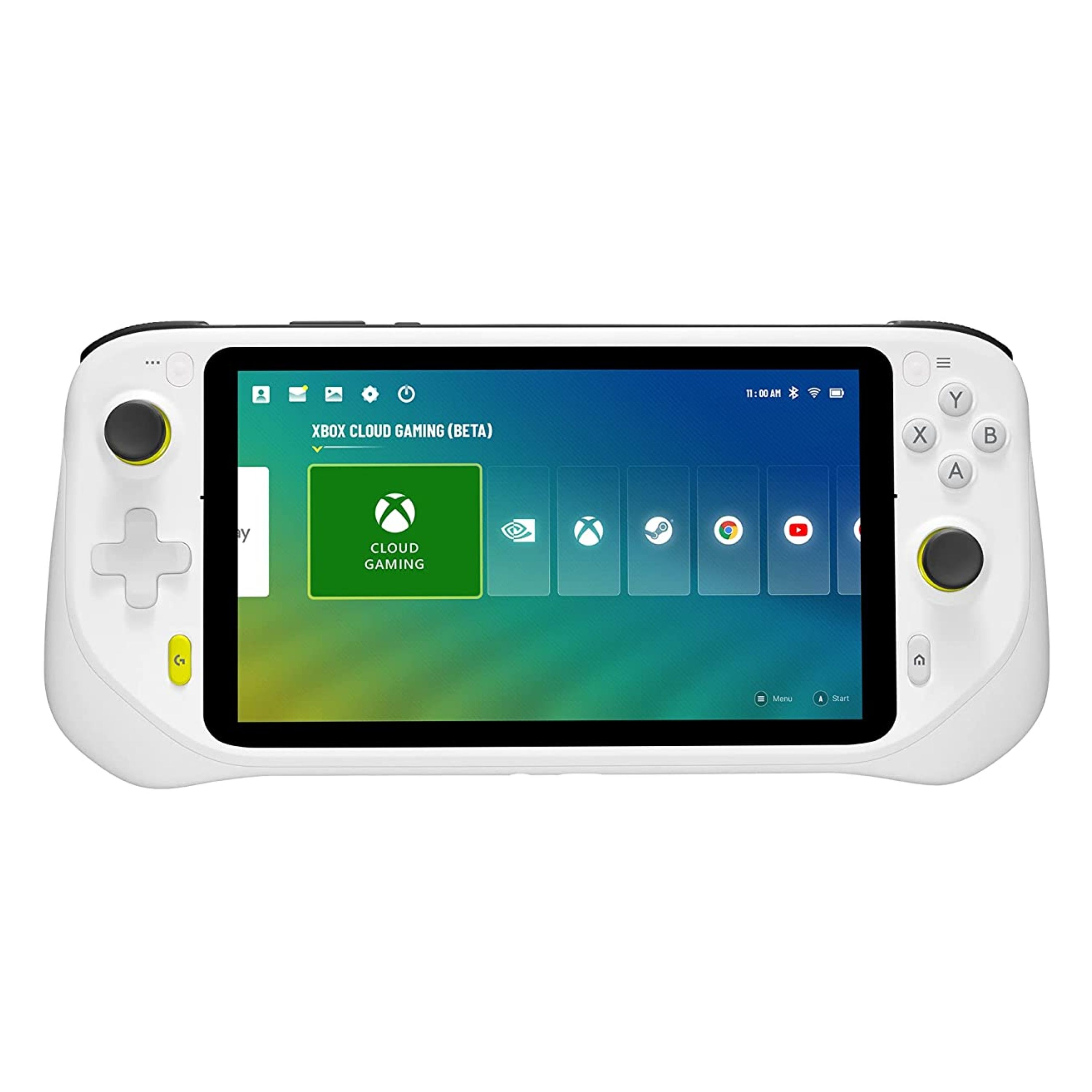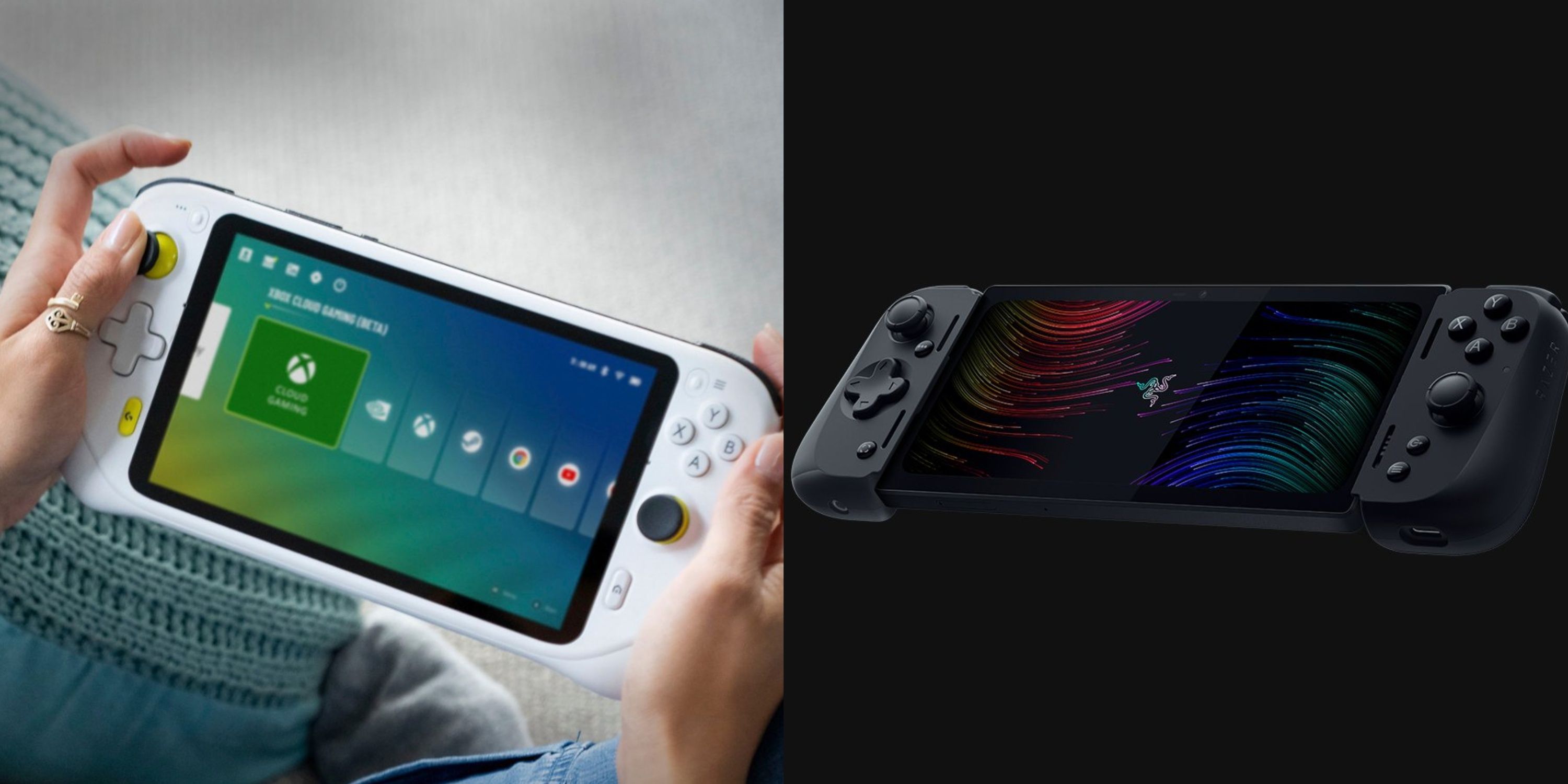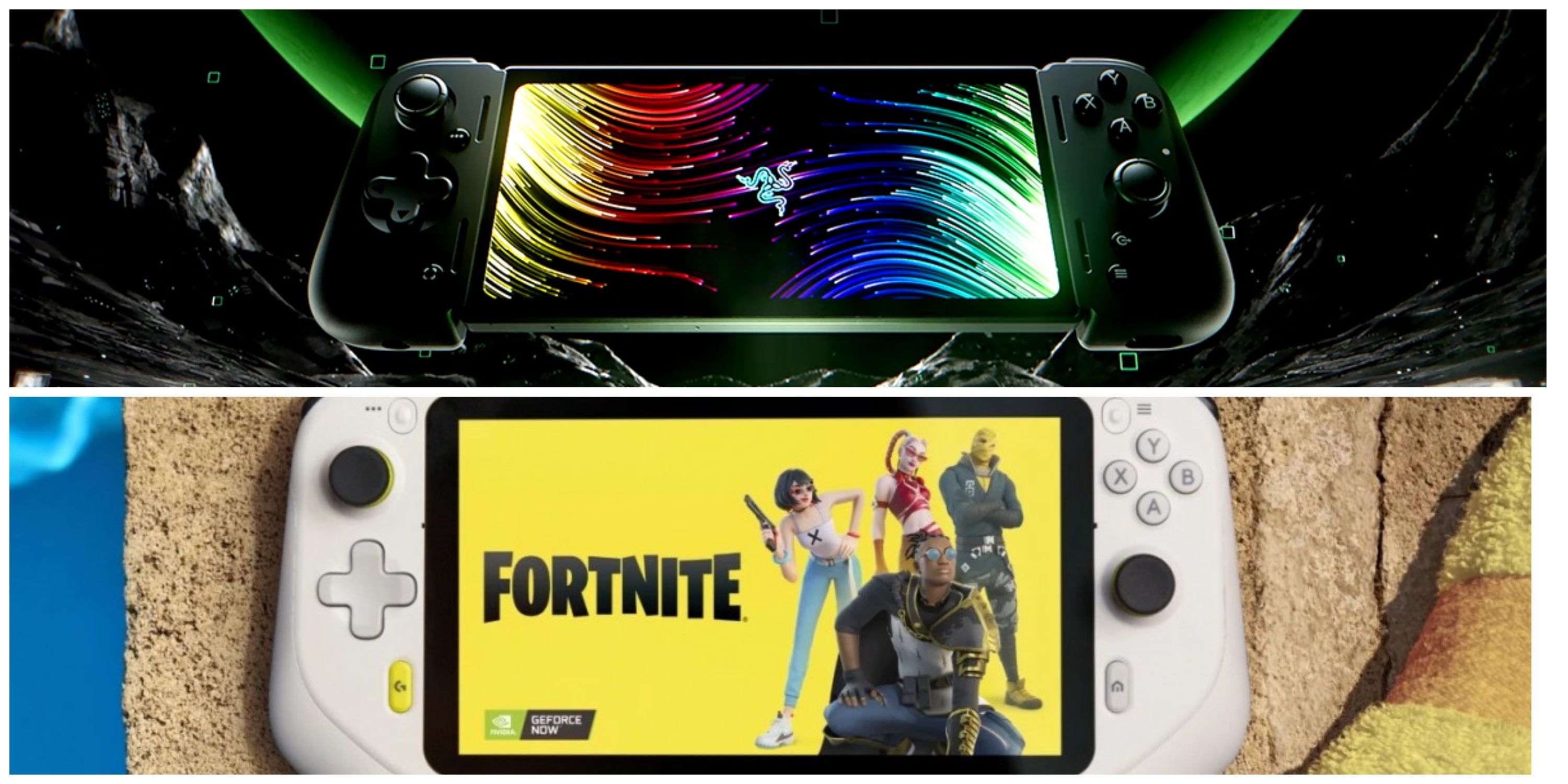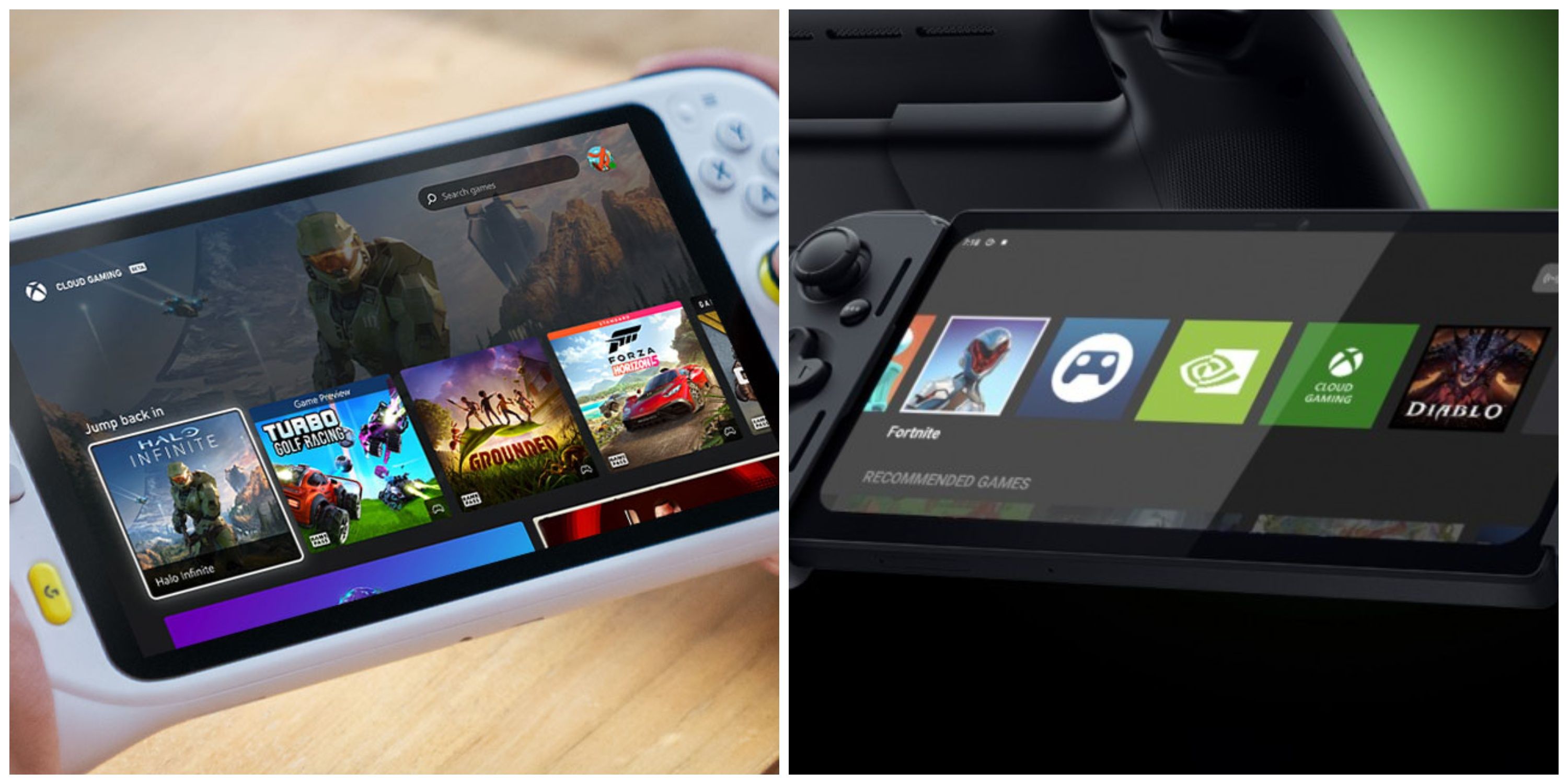The gaming community has grown a lot over the years to encompass a spectrum of gamers from pro esports competitors to mobile game fans who only play during down time between other activities. Mobile gamers in particular have evolved and changed quite a bit in recent years, with games like Minecraft and Fortnite offering mobile versions that opened the door to other AAA titles doing the same.
While there are still some handheld consoles, like the Switch, plenty of other respected manufacturers are trying their hand at the handheld android gaming device market. Two major players have recently released gaming handhelds worth taking a look at: Razer and Logitech. Both the Razer Edge and the Logitech G Cloud offer players a sleek device ready for cloud gaming, but which one is best for mobile gamers?
Specification | ||
|---|---|---|
Dimensions | 10.23 in (260 mm) x 3.35 in (85 mm) x 0.43 in (11 mm) | 10.11 in (257 mm) x 4.61 in (117 mm) x 1.30 in (33 mm) |
Weight | 401g / 0.88lbs | 463g / 1.02lbs |
Battery Life | 8 – 10 Hours | 9 – 12+ Hours |
Chipset | Snapdragon G3x Gen 1 (2021) | Qualcomm Snapdragon 720G (SD720G) (2020) |
RAM | 6 GB LPDDR5 | 16GB LPDDR5 |
Memory | 128 GB | 64 GB |
Wireless Connectivity | Wi-Fi 6E, 5G (Verizon version only) | Wi-Fi 5 |
Style & Comfort
These two android gaming handhelds couldn’t be styled more differently. On the one hand, there’s Razer’s dark and sleek Edge gaming handheld, which uses the pro-looking Razer Kishi as the controller. On the other hand is the bright, almost retro-looking handheld from Logitech, the G Cloud. The designs leave little unsaid: the Razer Edge is meant for more serious, competitive gameplay and the Logitech G Cloud is made for having fun at any place, any time. The all-black finish on the Edge is certainly a more polished look, while the G Cloud features a clean white finish paired with fresh lime-green accents that really pop.
The slightly bulbous shape of the G Cloud adds to its novelty aesthetic while simultaneously hinting at memories of the Xbox 360 controller, but this fun design belies the premium ergonomics at work. The bulky handles are contoured to fit any hand size comfortably, plus the texture along the back of the system adds comfort to the grip and keeps hands cool. The 463g/1.02lb weight means less resistance while holding the G Cloud for hours at a time, too.
The Razer Edge is lighter still though, with a total weight of just 401g/0.88lb (or 264g/0.58lbs without the controller attached), but there is a tradeoff for this: the Edge feels kind of cheap. Sure, the glossy finish on the almost weightless plastic shell is nice, but it is unmistakably thin plastic. The texture on the back does little to elevate things, with only a small amount placed on the bottom of the backs of each handle. Helping to cut down on the weight are shallow buttons that sadly don’t always feel as responsive as they actually are. On top of this, the joysticks are fairly normal-sized, which makes them feel out of place with the thin case and the short buttons. Despite the extra-lightweight build, the design of the Razer Edge lacks many ergonomic standards found on similar devices. It makes a better candidate for gaming while trapped in a waiting room, on a plane, or some other place where it can be played with the support of a desk or table after a few matches. Razer’s design seems to even encourages this, with the Kishi controller being fully removable and partially collapsible, making it super easy to carry in almost any bag.
Audio & Visuals
Both of these android gaming handhelds are approximately the same size, although Logitech’s is definitely chunkier. The main differences in size are due to the screen, which is technically bigger on the Razer Edge. However, the practical screen size on the Edge is hindered by an oversized bezel, which shrinks the screen by a significant amount and makes the whole gaming experience feel like it’s taking place in a widescreen-only theater.
This is a shame because the screen on the Razer Edge is much better than the Logitech G Cloud, featuring an AMOLED FHD+ touchscreen with the newest industry premium refresh rate of 144hz. But the combination of an annoyingly thick bezel and the usable screen being 6.8” instead of meeting Logitech’s 7” screen, makes the visual category a loss for Razer as well. After all, it’s not as though Logitech cut corners on their screen. In fact, they seemed to have hit their mark of offering an affordable, yet competitive screen quality with their 1080p HD touchscreen, which has a respectable refresh rate of 60hz. Sure, there’s nothing incredible happening with this screen, but when it comes to handhelds it’s not always necessary to go all-out.
Even though Razer’s screen is more advanced than Logitech’s, both the Edge and the G Cloud have beautifully bright, bold displays that capture all the best parts of every game, to the point that it can be difficult to spot major differences between the two. Even the app displays are similar, as both handhelds have gone with the standard widget layout that can be found on consoles and tablets. This makes for very accessible devices, as the icons are large and easy to navigate.
Both devices have impressive sound tech, featuring dual audio and built-in mics. The Razer Edge boasts THX spatial audio through its two 2-way speakers. The sound quality is excellent, but it’s somewhat unrealistic to think that those speakers will be used much on a device built for travel and public spaces. Here again, Logitech cuts back on a feature that doesn’t need the attention, only providing players with basic surround sound from their two speakers. Like the Edge, the G Cloud offers built-in mics embedded alongside their speakers, but Logitech’s design includes echo cancelling and noise suppression to help with discreet speech-to-text usage even on the go.
For gamers who don’t want to be the inconsiderate person on the train, both the Edge and the G Cloud offer a standard headphone jack and bluetooth connectivity for players to use their favorite headset. Logitech also offers a USB-C port for headsets that can work while charging or that rely on a wireless dongle. So while Razer’s audio specs are top of the line for an android gaming handheld, both devices have plenty of ways for players to use their own quality headsets and avoid disrupting others or being disrupted themselves.
Connectivity & Power
Both the Razer Edge and the Logitech G Cloud allow players to connect to a wide variety of game libraries, creating few limitations for those with the right subscriptions. Along with the Play Store, the Razer Edge comes preloaded with the Razer Nexus App, Xbox Game Pass, NVIDIA GeForce Now, Steam Link, Epic Launcher, and Parsec. Logitech pairs the Play Store with Xbox GamePass, Steam, and NVIDIA GeForce NOW preloaded.
Being a bit older, the Logitech G Cloud can seem a bit lacking when it comes to connectivity. The fact is, the Razer Edge uses the newer WiFi 6E while the Logitech G Cloud is still tied to WiFi 5. Plus, the Edge has a Verizon-supported version that can also connect to 5g.
Unfortunately, both handheld systems have reviews that report issues with connectivity, particularly in airports and on planes. For the Razer Edge, this is almost a non-problem. Cloud gaming is primarily what the device is made for, but downloading a game and playing offline is more than possible. There’s only 128 GB of space on the Razer Edge, but that’s enough for one or two big games that will get players through a long flight. Gamers who opt for the Verizon version of Razer’s handheld will have even less issues when the WiFi isn’t cooperating.
That’s basically what it comes down to for the Logitech G Cloud, which does its best work from home. Outside of good sources of WiFi (like at school, work, or home) the G Cloud is spotty at best, but it’s worth keeping in mind that it was designed for relaxing away from a full console or PC, not for commuting. The Razer set out to be a fully mobile gaming handheld, and achieved that goal. Likewise, the G Cloud successfully acts as a mobile gaming system for lounging around.
While Razer fans are running around with the Edge, they’ll be going through power a bit faster than the Logitech crowd. The Razer Edge uses a lithium-ion battery with a lifespan of 8-10 hours, while the Logitech G Cloud uses a lithium polymer battery that allows it to run for about 9-12 hours. Ever the battery specialists, Logitech’s model of course has a little extra power for players who choose to lower the performance settings, with some users reporting up to 14 hours of battery life.
Verdict
Both the Razer Edge and the Logitech G Cloud are good android gaming handhelds, but where the Edge tries to make everything the very best with little reasoning, Logitech has a clear target audience in mind.
Their slightly chunky, retro-style handheld is perfect for carrying anywhere, especially around the house, while waiting for an appointment, or in hotel rooms during downtime. Many parents have noted how useful it is for fitting game time in between activities for the kids, or during the 100th showing of Encanto. Similarly, mobile gamers who are becoming increasingly curious about AAA games like The Witcher 3 and Fortnite can jump in without having to commit to a whole new setup for a gaming PC or a console.
While the Razer Edge has a lot of great features, Logitech’s handheld has features that their target audience really wants. The built-in mic is great for quick messaging, the screen is big and bold, and the wide headset compatibility doesn’t make assumptions about the user’s previous gaming experience. On top of this, Logitech’s ergonomic design and lightweight build makes it easy to play while relaxing, and the bright style is a refreshing option amongst a sea of glossy black devices.
Overall, the Logitech G Cloud is better than the Razer Edge. Put simply, the Edge lacks direction and relies a bit too much on flashy specs that aren't especially useful on the go. Logitech’s G Cloud is an ergonomic gaming device made with mobile and other casual players in mind.
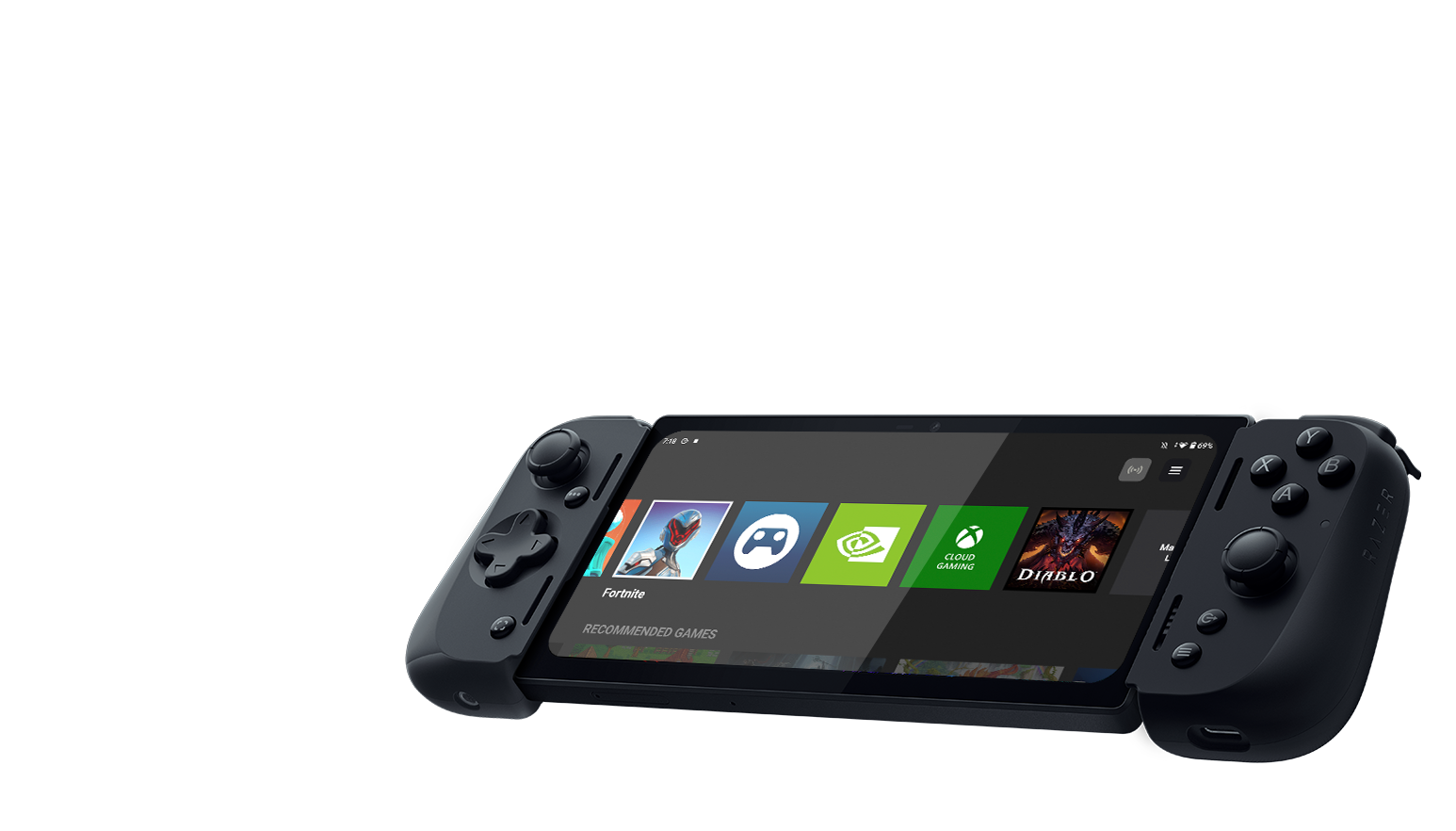
Razer Edge
The Razer Edge is custom-built to be the ultimate Android gaming handheld.
The exclusive Snapdragon G3x Gen 1 delivers unrivaled performance, the 144Hz AMOLED display offers incredible clarity at high speeds, and Kishi V2 Pro is a console-quality controller for compatible Android and Xbox games.
- Brand
- Razer
- Screen
- 6.8-inch AMOLED display with FHD+
- Storage
- 128GB
- CPU
- Snapdragon G3x Gen 1
- Dimensions
- 260 X 85 X11 mm
- Great game performance
- Very durable build quality
- Perfectly portable
- Expensive
- Battery life is limited
- Displays is lacking

